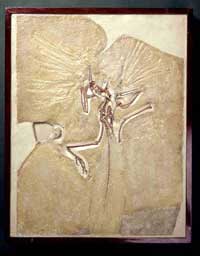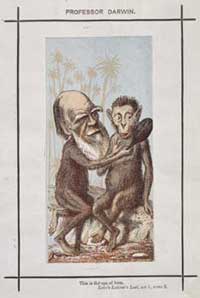| |
|
Archaeopteryx fossil skeleton |
||
 |
||
|
The
story began more than 150 years ago. In 1859, Darwin published his
new and immensely controversial theory of evolution by natural selection.
The scientific community, the Church and the national press began
a great debate - had all living things been created together or
had they each adapted and changed over time, some becoming extinct
while others prospered? Then, in 1861, Archaeopteryx, thought to be the
most ancient known bird, was discovered in a limestone quarry in
Solnhofen, Germany. Archaeopteryx became a focus for the
debate on evolution because of its peculiar set of features: it
had feathers like a bird, but it also had teeth and clawed fingers
- like a dinosaur. |
|
Charles Darwin was ridiculed, as in this cartoon, when he published his theory of evolution in 1859 |
Darwin's theory became established, but how Archaeopteryx had evolved remained a hot topic until 1968, when the American palaeontologist John Ostrom discovered a dinosaur he named Deinonychus. He realised it shared several unique features with Archaeopteryx - features suggesting they were more closely related to each other than to any other animal. But not all scientists agreed that a voracious, predatory dinosaur could possibly be the closest relation of the first known bird. They wanted to see conclusive proof - feathered dinosaurs. But these lay undiscovered in China until the end of the twentieth century. |


